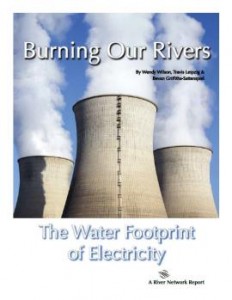 When we think of what it takes to produce electricity, we tend to think coal, natural gas, nuclear. Maybe, wind and sun. You may think about carbon emissions. But do you think water? Heaps and heaps of water? In a new report from the River Network, Burning Our Rivers: The Water Footprint of Electricity, we learn that it takes 42 gallons of water to produce a single kilowatt hour of electricity. What this means, in effect, is that the actual water use in an average household is 5 times more that what you see on the water bill when you factor in the water it takes to power our homes. More than half of all the freshwater withdrawn from surface waters in the United States goes to supporting the production of power. In truth, it takes a lot of water to keep the lights on.
When we think of what it takes to produce electricity, we tend to think coal, natural gas, nuclear. Maybe, wind and sun. You may think about carbon emissions. But do you think water? Heaps and heaps of water? In a new report from the River Network, Burning Our Rivers: The Water Footprint of Electricity, we learn that it takes 42 gallons of water to produce a single kilowatt hour of electricity. What this means, in effect, is that the actual water use in an average household is 5 times more that what you see on the water bill when you factor in the water it takes to power our homes. More than half of all the freshwater withdrawn from surface waters in the United States goes to supporting the production of power. In truth, it takes a lot of water to keep the lights on.
Water is used in the mining, cleaning and transport of the raw materials for energy production. At the plant, water is used for cooling and in various processes. It is withdrawn from local sources and either lost as steam or released into surface waters at high temperatures and with pollutant loads that can lead to algal blooms, fish kills and other impacts to our lakes and streams. For hydropower, water evaporates from reservoirs behind dams in quantities that exceed even the water demands at fossil fuel plants. Wind and solar require very little water.
The report highlights some key ways to reduce the impacts to water from the production of electricity. The use of water-efficient technologies at power plants and a shift to low water intensity alternatives to supply more of our energy needs will go a long way toward reducing the water footprint of electricity.
At home, simple energy and water conservation measures can help on many fronts. Turning off lights, shifting to low energy bulbs and installing high efficiency appliances will contribute to water conservation, reduce carbon emissions and save you money. A win-win-win. More and more utilities are offering the option to supply a portion of your electricity from alternative sources such as wind and solar. Enrolling in these programs (such as DTE’s GreenCurrents or Consumer Energy’s Green Generation) can also help reduce our collective water footprint and encourage the development of low water intensity energy sources.
For more ideas on how to reduce your energy and water use take a look at our Saving Water Saves Energy project’s top ten tips.



